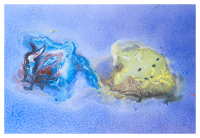Conveners
Parallel V: F2 Nuclear and Astroparticle Physics
- Andreas Schmitt (Vienna University of Technology)
Stefan Petschauer
(TU München)
08/09/2014, 16:30
Section F: Nuclear and Astroparticle Physics
We use SU(3) chiral effective field theory to describe the two- and three-baryon forces. Results for the hyperon-nucleon interaction at next-to-leading order are reported. These potentials include one- and two-meson exchange diagrams as well as contact terms with SU(3) symmetric low-energy constants. Furthermore we present potentials for the leading order three-baryon interactions, which...
Evgeny Epelbaum
(University of Bochum)
08/09/2014, 16:50
Section F: Nuclear and Astroparticle Physics
I review recent progress in the application of chiral effective field theory
to nuclear forces and low-energy nuclear observables. Both the continuum
and the lattice formulations will be addressed.
Yoichi Ikeda
(RIKEN)
08/09/2014, 17:10
Section F: Nuclear and Astroparticle Physics
One of the interesting subjects in hadron physics is to look for the multiquark configurations. One of candidates is the H-dibaryon (udsuds), and the possibility of the bound H-dibaryon has been recently studied from lattice QCD.
We also extend the HAL QCD method to define potential on the lattice between baryons to meson-meson systems including charm quarks to search for the bound tetraquark...
Philipp Gubler
(RIKEN)
08/09/2014, 17:30
Section F: Nuclear and Astroparticle Physics
The behavior of the $\phi$ meson at finite density is studied, making use of a QCD sum rule approach in combination with the maximum entropy method. It is demonstrated that a
possible mass shift of the $\phi$ in nuclear matter is strongly correlated to the strangeness content of the nucleon, which is proportional to the strange sigma term, $\sigma_{sN}$. In contrast to earlier studies, our...
Oton Vazquez Doce
(Excellence Cluster Universe, TU-Munich.)
08/09/2014, 17:50
Section F: Nuclear and Astroparticle Physics
The hyperon-pion and hyperon-nucleon(s) correlations following K- nuclear absorption in Helium and Carbon were investigated with the KLOE drift chamber and the results will be presented. To this end, KLOE [1] data (from 2004-2005) was analyzed using the detector itself as an active target. Also results from a more recent run (end of 2012) with a dedicated solid Carbon target will be...
